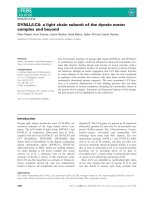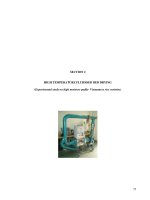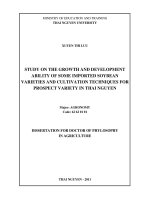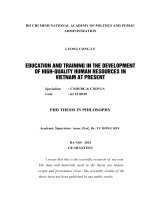Development of high hydrogen capacity complex and chemical hydrides for hydrogen storage
Bạn đang xem bản rút gọn của tài liệu. Xem và tải ngay bản đầy đủ của tài liệu tại đây (4.38 MB, 207 trang )
DEVELOPMET OF HIGH HYDROGE CAPACITY
COMPLEX AD CHEMICAL HYDRIDES FOR
HYDROGE STORAGE
CHUA YOG SHE
ATIOAL UIVERSITY OF SIGAPORE
2011
DEVELOPMET OF HIGH HYDROGE CAPACITY
COMPLEX AD CHEMICAL HYDRIDES FOR
HYDROGE STORAGE
CHUA YOG SHE
(B.Sc. (Hons.), UTM)
A THESIS SUBMITTED
FOR THE DEGREE OF DOCTOR OF PHILOSOPHY
DEPARTMET OF CHEMISTRY
ATIOAL UIVERSITY OF SIGAPORE
2011
I
Acknowledgements
First of all, I would like to express my sincere appreciation to my
supervisors, Prof. Chen Ping and Prof. Richard Wong for their support throughout
my PhD candidature, especially to Prof. Chen Ping for her constant care, guidance
and invaluable instruction. I would also like to express my sincere gratitude to Prof.
Xiong Zhitao and Assoc. Prof. Wu Guotao for their precious guidance and advice
in laboratory skills and structural analyses.
Special thanks also go to Dr S Thomas Autrey, Dr Abhi Karkamkar and Dr
Wendy J. Shaw from Pacific Northwest National Laboratory (PNNL) for their
useful discussion and assistance in high field NMR experiments in the
collaboration works.
I also want to thank all current and past members in Prof. Chen’s group,
whose assistance and encouragement composed every step in the past four years’
research course.
I would like to thank National University of Singapore for providing the
PhD research scholarship. Much appreciation also goes to the staffs of the
CMMAC laboratories, especially Mdm. Han Yan Hui and Mr. Wong Chee Ping for
NMR support. I am also thankful to the assistance that I have received from the
laboratory officers of Surface Science Laboratory, Mr. Wong How Kwong and Mr.
Ho Kok Wen.
II
Finally and most importantly, I would like to thank my family and friends,
especially Ng Jeck Fei and New Siu Yee, for their support throughout the years.
III
Table of Contents
Acknowledgements I
Table of Contents III
Summary VIII
List of Tables XI
List of Figures XIII
List of Schemes XXII
Chapter 1 Introduction 1
1.1 DOE target for hydrogen storage 2
1.2 Materials for hydrogen storage 3
1.2.1 Metal hydrides 6
1.2.2 Complex hydrides 9
1.2.2.1 Activation for hydrogen release from
complex aluminum hydride
11
1.2.3 Chemical hydrides 12
1.2.3.1 Proposed dehydrogenation mechanism 16
1.2.3.2 Activation for hydrogen release from AB 17
1.3 Thermodynamic alteration on hydrides 20
1.3.1 Destabilization 20
1.3.2 Amide-hydride interaction 23
1.3.3 Cationic substitution 28
IV
1.3.3.1 Interaction of metal hydride and AB 28
1.3.3.1.1 Driving forces and reaction
mechanisms
31
1.3.3.2 Interaction of metal amide/imide/nitride
with AB
34
1.4 Motivation 35
Chapter 2 Experimental
38
2.1 Sample preparation and synthesis 38
2.1.1 Solid state ball milling 38
2.1.2 Liquid state reaction 39
2.2 Dehydrogenation 39
2.2.1 Open system dehydrogenation 39
2.2.2 Close system dehydrogenation 40
2.3 Characterizations 40
2.4 Quantification of NH
3
41
Chapter 3 Investigations on the solid state interactions between
lithium alanate with binary and complex amides
42
3.1 Introduction 42
3.2 Experimental section 43
3.2.1 Sample preparations and synthesis 43
3.2.2 Characterizations 45
3.3 Results and discussion 45
V
3.3.1 Reaction of lithium alanate with sodium amide 45
3.3.1.1 Metathesis between LiAlH
4
and NaNH
2
45
3.3.1.2 Dehydrogenation 50
3.3.1.3 Proposal of reaction mechanisms 53
3.3.1.4 Thermal decompositions of the post milled
products
56
3.3.2 Reaction of lithium alanate with lithium aluminum
ternary amide
58
3.3.2.1 Hydrogen release from the interaction of
LiAlH
4
and LiAl(NH
2
)
4
58
3.3.2.2 Dehydrogenation pathway 64
3.4 Conclusion 68
Chapter 4 Syntheses, structures and dehydrogenations of alkaline
earth metal amidoboranes and their ammoniate complexes
70
4.1 Introduction 70
4.2 Experimental section 75
4.2.1 Sample preparations 75
4.2.2 Characterization 77
4.3 Results and discussion 78
4.3.1 Calcium amidoborane (CaAB) 78
4.3.1.1 Synthesis and crystal structure 78
4.3.1.2 Dehydrogenation 82
4.3.2 Calcium amidoborane diammoniate (CaAB·2NH
3
) 83
4.3.2.1 Optimization 83
VI
4.3.2.2 Crystal structure 85
4.3.2.3 Deammoniation 91
4.3.2.4 Dehydrogenation 94
4.3.3 Calcium amidoborane monoammoniate (CaAB·NH
3
) 103
4.3.3.1 Tuning NH
3
content in CaAB·2NH
3
103
4.3.3.2 Crystal structure 106
4.3.3.3 Deammoniation 107
4.3.3.4 Dehydrogenation 108
4.3.4 Magnesium amidoborane diammoniate (MgAB·2NH
3
) 112
4.3.4.1 Optimization 113
4.3.4.2 Dehydrogenation 116
4.3.5 Magnesium amidoborane monoammoniate…………….
(MgAB·NH
3
)
119
4.3.5.1 Crystal structure 121
4.3.5.2 Dehydrogenation 126
4.4 Conclusion 131
Chapter 5 Mechanistic investigation on the formation and
dehydrogenation of calcium amidoborane diammoniate by
15
H
3
and D
3
isotopic substitution
133
5.1 Introduction 133
5.2 Experimental section 135
5.2.1 Materials and synthesis 135
5.2.2 Characterization 136
VII
5.3 Results and discussion 136
5.3.1 Mechanistic understanding on the formation of calcium
amidoborane diammoniate
136
5.3.2 Dehydrogenation mechanism of calcium amidoborane
diammoniate
140
5.4 Conclusion 150
Chapter 6 Thermodynamic modification on calcium amidoborane 151
6.1 Introduction 151
6.2 Experimental section 152
6.2.1 Sample preparations 152
6.2.2 Characterization 153
6.3 Results and discussion 153
6.3.1 Optimization 153
6.3.2 Dehydrogenation 158
6.4 Conclusion 163
Chapter 7 Conclusions and future work 164
References
169
Appendix
181
VIII
Summary
The depletion of fossil fuel stimulates tremendous efforts in setting up a
sustainable energy system. Because of its abundance, high energy output and zero
emission hydrogen is recognized as the most prospective energy carrier for the
future energy system. To utilize H
2
as a fuel for transportation, a safe and efficient
storage medium is needed.
Lithium aluminum hydride (LiAlH
4
) and ammonia borane (AB) possess
high hydrogen content of 10.5 wt% and 19.6 wt%, respectively, and thus, are
attractive for hydrogen storage. However, direct uses of these chemicals for
hydrogen storage are not feasible due to their poor dehydrogenation kinetic and
thermodynamic properties. Therefore, the aim of this study is to improve the
dehydrogenation properties of LiAlH
4
and AB by chemically altering (or
modifying) their dehydrogenation thermodynamics.
Significant improvement in the dehydrogenation properties of LiAlH
4
has
been achieved by reacting it with NaNH
2
or LiAl(NH
2
)
4
. As results of chemical
alterations, LiAlH
4
underwent different dehydrogenation pathways, releasing
hydrogen rapidly under ambient temperature. In the dehydrogenation process, the
large combination potential of H
δ+
and H
δ-
to H
2
together with the formation of
thermodynamic favorable Al-N bond induce a direct interaction of the materials to
form H
2
, giving rise to the formation of Li-Al-N-H product.
IX
In the chemical modification of AB by reacting it with calcium amide in
THF solvent, high purity calcium amidoborane (CaAB) was yielded; whereas in a
solid-state reaction of AB with Ca or Mg amides or imides, a new class of materials,
namely metal amidoborane ammoniate, with high hydrogen content was discovered.
These newly developed materials possess high hydrogen content of > 11 wt% and
demonstrate attractive dehydrogenation behaviors. In the study, NH
3
was found to
play a vital role in stabilizing crystal structures of ammoniates, forming strong
coordination with metal cation and establishing a complete dihydrogen bond
network within the structures. As a consequence of dihydrogen bonding, N-H and
B-H bonds are weakened, resulting in a significant reduction in dehydrogenation
temperature. Furthermore, stoichiometric conversion of NH
3
to H
2
was achieved,
allowing more hydrogen to be released in the dehydrogenation.
Due to the attractive properties of amidoborane ammoniates, mechanisms of
their formation and dehydrogenation were studied by using isotopic labeling. It was
found that the formation of ammoniate sample was attributed to the combination of
one H
δ+
from AB and [NH
2
]
-
unit in amide, i.e. Ca(NH
2
)
2
, to form NH
3
, and the
remaining [NH
2
BH
3
]
-
unit of AB may bond to Ca
2+
as a result of electrostatic force.
In the investigation of the dehydrogenation mechanism, it was evidenced that the
improved dehydrogenation properties in amidoborane ammoniate was resulted
from the participation of NH
3
molecule in the dehydrogenation of metal
amidoborane.
X
Stimulate by the mechanistic study, the dehydrogenation thermodynamics of
CaAB was chemically modified by reacting it with LiNH
2
and the results showed
that an even lower dehydrogenation temperature with a milder reaction enthalpy
can be achieved in comparison to that of CaAB.
Overall, significant improved dehydrogenation properties have been
achieved in the chemically modified materials as compared to the pristine materials
(LiAlH
4
and AB). A few new materials were synthesized which exhibit remarkable
dehydrogenation properties.
XI
List of Tables
Table 1.1
DOE targets for onboard hydrogen storage systems for
light-duty vehicles.
3
Table 1.2
Comparisons on currently available hydrogen storage methods.
6
Table 1.3
Amide-hydride combinations for hydrogen storage.
Reproduced with permission from Ref. 93
25
Table 4.1
Calculated structural parameters of CaAB (space group C2, No
5, a = 9.2220 Å, b = 4.3472 Å, c = 6.4996 Å, β = 93.33°)
82
Table 4.2
Calculated structural parameters of CaAB·2NH
3
(space group
Pna21, No. 33, a = 18.6301 Å, b = 5.2913 Å, c = 8.5016 Å).
87
Table 4.3
Interatomic distances (Å) and bond angles (º) for dihydrogen
bonds in CaAB·2NH
3.
89
Table 4.4
Calculated structural parameter of Mg(NH
2
BH
3
)·NH
3
(space
group P21/A, a = 8.8174 Å, b = 9.0794 Å, c = 8.1299 Å and β
= 95.2014 °).
122
Table 4.5
Interatomic distances (Å) and bond angles (
o
) in crystal
structure of Mg(NH
2
BH
3
)·NH
3
.
122
Table 4.6
Calculated structural parameter of Mg(NH
2
BH
3
)
2
(space group
C2, a = 8.5722 Å, b = 5.6048 Å, c = 5.6216 Å and β = 85.8476
°)
124
Table 4.7
Interatomic distances (Å) and bond angles (
o
) in crystal
structure of Mg(NH
2
BH
3
)
2
.
125
XII
Table 4.8
Amount of NH
3
coproduced in the dehydrogenation process of
MgAB·NH
3
129
XIII
List of Figures
Figure 1.1
Representation of physisorption (cryosorption) and
chemisorption processes. Reproduced with permission from
Ref. 7. Reproduced by permission of the PCCP Owner
Society.
5
Figure 1.2
Low-temperature (orthorhombic) crystal structure of
ammonia borane (AB). N, B and H atoms are depicted in
blue, purple, and gray, respectively. The dihydrogen bonds
are delineated by dashed lines. Reproduced with permission
from Ref. 53.
13
Figure 1.3
Energy diagram on hydride destabilization through alloy
formation. Reproduced with permission from Ref. 13.
21
Figure 1.4
Weight variations during hydrogen absorption and
desorption processes over Li
3
N samples. Abs: absorption;
Des: desorption. Reproduced with permission from Ref 16.
24
Figure 1.5
Schematic diagram of the crystal structure of LiNH
2
BH
3
and
NaNH
2
BH
3
determined from high-resolution X-ray powder
diffraction data at room temperature. Boron is represented
by orange spheres; nitrogen by green spheres; hydrogen by
white spheres and lithium by red spheres. Reproduced with
permission from Ref 80
29
Figure 1.6
Time dependence of hydrogen desorption from alkali
amidoboranes and post milled BH
3
NH
3
sample at about 91
°C. Reproduced with permission from Ref 80.
30
Figure 1.7
Schematic energy profiles for the L* (oligomerization) and
L (non-oligomerization) pathways of dehydrogenation in
(LiNH
2
BH
3
)
2
. Reproduced with permission from Ref 112.
33
XIV
Figure 3.1
XRD patterns of self made LiAl(NH
2
)
4
and LiAlH
4
44
Figure 3.2
Time dependences of hydrogen evolution from the S-I
(LiAlH
4
-2NaNH
2
) and S-II (2LiAlH
4
-NaNH
2
) samples in
the milling process, respectively
46
Figure 3.3
FTIR spectra of the S-I and S-II samples collected at
different reaction stages.
48
Figure 3.4
XRD patterns of the S-I (LiAlH
4
-2NaNH
2
) sample collected
at different reaction stages.
48
Figure 3.5
XRD patterns of the S-II (2LiAlH
4
-NaNH
2
) sample
collected at different reaction stages.
49
Figure 3.6
27
Al,
23
Na and
7
Li NMR spectra of samples collected at
different milling stage of the S-I and S-II. (a-b) S-I stage 2
and 4, (c-d) S-II stage 2 and (e-f-g) are LiAlH
4
, LiAl(NH
2
)
4
and LiH included for comparison.
53
Figure 3.7
DSC (a) and TPD (b) measurements on the post milled
products of S-I (solid line) and S-II (dash line) samples.
57
Figure 3.8
Time dependences hydrogen desorption from ball milling
LiAlH
4
-LiAl(NH
2
)
4
mixtures at the mole ratios of 1:1 and
3:1 at ambient temperature.
59
Figure 3.9
TPD-MS curves of LiAl(NH
2
)
4
/LiAlH
4
(1:3) homogenous
(up) and pure LiAl(NH
2
)
4
(down).
60
Figure 3.10
DSC measurement of LiAl(NH
2
)
4
and homogenous mixing
LiAl(NH
2
)
4
-LiAlH
4
(1:3).
61
XV
Figure 3.11
Volumetric release of grinded LiAl(NH
2
)
4
-LiAlH
4
(1:3). 62
Figure 3.12
XRD pattern of LiAlH
4
/LiAl(NH
2
)
4
(1:3) homogenous
mixing (a), evolved 8 equiv. H (b), 10 equiv. H (c), 16 equiv.
H (d) and post milled LiAlH
4
/LiAl(NH
2
)
4
(1:1) (e). Peaks
correspond to platinum (Pt) are marked with asterisks.
66
Figure 3.13
FTIR spectra of self-made LiAl(NH
2
)
4
(a),
LiAl(NH
2
)
4
/LiAlH
4
(1:3) evolved 8 equiv. H (b), 10 equiv H
atoms (c) and 16 equiv. H atoms (d).
66
Figure 3.14
27Al (A) and 7Li (B) MAS solid state NMR spectra and
post milled LiAl(NH
2
)
4
/LiAlH
4
(1:3) with 16 H evolved (a),
10 H evolved (b), 8 H evolved (c), homogenous mixing (d),
LiAl(NH
2
)
4
(e), LiH (f), AlN(g) and LiAlH
4
(h). Asterisks
denote the spinning sidebands.
67
Figure 4.1
Time dependence of NH
3
release from the reaction between
Ca(NH
2
)
2
-2AB in THF solution at 25 °C.
79
Figure 4.2
Proton coupled (top) and decoupled (bottom)
11
B NMR
spectra of calcium amidoborane.
80
Figure 4.3
XRD pattern of calcium amidoborane (CaAB) upon THF
removal.
80
Figure 4.4
Molecular packing and close contacts in crystal CaAB.
Calcium is represented by green spheres, nitrogen by blue
spheres, boron by pink spheres and hydrogen by white
spheres.
81
Figure 4.5
TPD-MS measurement on the CaAB synthesized by
reacting Ca(NH
2
)
2
and 2 equiv. of AB in THF.
82
XVI
Figure 4.6
XRD patterns of the mixture of Ca(NH
2
)
2
-AB with the
molar ratios of 1:1, 1:2 and 1:4 collected after 10 hours of
ball milling.
84
Figure 4.7
XRD patterns of the mixture of Ca(NH
2
)
2
-AB with the
molar ratio of 1:2 collected at different ball milling
intervals.
84
Figure 4.8
(A) XRD patterns of AB, Ca(NH
2
)
2
, CaAB (derived by
heating CaAB2NH
3
at 100
o
C in vacuum) and CaAB2NH
3
.
(B) Experimental (smooth line) and calculated (+) profiles
of CaAB2NH
3
. The differences between the experimental
and calculated values were shown below the observed
patterns.
85
Figure 4.9
Molecular packing and network of N–H···H–B dihydrogen
bonding in crystal CaAB2NH
3
. Calcium is represented by
green spheres, nitrogen by blue spheres, boron by pink
spheres and hydrogen by white spheres.
88
Figure 4.10
FTIR spectra of Ca(NH
2
)
2
, AB, CaAB2NH
3
and the
post-dehydrogenated CaAB2NH
3
sample.
88
Figure 4.11
11
B MAS solid state NMR spectra of AB, CaAB,
CaAB2NH
3
and post-dehydrogenated CaAB2NH
3
sample.
89
Figure 4.12
DSC and TPD measurements on the decomposition of
CaAB2NH
3
.
92
Figure 4.13
XRD pattern of the sample collected after ammoniation of
CaAB. Asterisks denote the XRD reflections of
CaAB2NH
3
.
92
Figure 4.14
Volumetric release of CaAB and CaAB2NH
3
. Temperature
was raised to 300 °C at a ramping rate of 0.5 °Cmin
-1
.
94
XVII
Figure 4.15
Volumetric release of CaAB2NH
3
at 80 °C. Temperature
was raised to 80 °C at a ramping rate of 0.5 °Cmin
-1
and
held for 2 hours.
95
Figure 4.16
MS measurement of the gaseous product collected after
heating CaAB2NH
3
at 80 °C for 2 hours. H
2
is the main
gaseous product.
96
Figure 4.17
Volumetric release of CaAB2NH
3
at different ramping rate
to 150 °C and held for overnight.
97
Figure 4.18
MS measurement of the gaseous product collected after
heating CaAB2NH
3
to 150 °C at the rate of 0.5 °Cmin
-1
. H
2
is the main gaseous product.
98
Figure 4.19
MS measurement of the gaseous product collected after
heating CaAB2NH
3
to 150 °C at the rate of 2 °Cmin
-1
. H
2
is
the main gaseous product.
98
Figure 4.20
MS measurement of the gaseous product collected after
heating CaAB2NH
3
to 150 °C at the rate of 5 °Cmin
-1
. H
2
is
the main gaseous product.
99
Figure 4.21
Volumetric release of CaAB2NH
3
at pre-set temperatures. 101
Figure 4.22
DSC and TPD measurements on the CaAB2NH
3
collected
after volumetric release at (i) 90 °C, (ii) 130 °C and (iii) 150
°C, respectively.
102
Figure 4.23
C80 measurement of CaAB2NH
3
. 102
Figure 4.24
XRD patterns of the post milled CaAB2NH
3
+ nCaAB
samples, with n = 1, 2 and 3. XRD spectra of CaAB and
CaAB2NH
3
(n = 0) were included for comparison.
104
XVIII
Figure 4.25
Raman spectra of the post milled CaAB2NH
3
+ nCaAB
samples with n = 1, 2 and 3. CaAB and CaAB2NH
3
(n = 0)
were also included for comparison.
105
Figure 4.26
XRD patterns of post milled CaNH-2AB and CaAB2NH
3
+
CaAB samples.
106
Figure 4.27
DSC and TPD measurements on the post milled
CaAB2NH
3
+ nCaAB samples with n = 1, 2 and 3.
107
Figure 4.28
Volumetric release measurements of the post milled
CaAB2NH
3
+ nCaAB samples with n = 1, 2 and 3.
Temperature was raised to 300 °C at a ramping rate of 0.5
°C/min.
109
Figure 4.29
C80 measurements of post milled CaAB2NH
3
+ nCaAB
samples with n = 1, 2 and 3. Temperature was raised to 300
°C at a ramping rate of 0.5 °C/min.
109
Figure 4.30
FTIR measurements on the post dehydrogenated
CaAB2NH
3
+ nCaAB samples with n = 1, 2 and 3.
110
Figure 4.31
Reactions of NH
3
BH
3
(AB) and hydrides in THF. 112
Figure 4.32
XRD patterns of the post milled Mg(NH
2
)
2
-AB in the molar
ratios of 1:1 and 1:2.
114
Figure 4.33
11
B solid state MAS NMR measurements of the mixture of
Mg(NH
2
)
2
-AB in the molar ratio of 1/2 before and after
being treated at different temperatures.
11
B NMR spectra of
AB was included for comparison.
114
Figure 4.34
FTIR spectra of AB, MgAB2NH
3
and the
post-dehydrogenated MgAB2NH
3
sample.
115
XIX
Figure 4.35
DSC and TPD measurements on the decomposition of
MgAB2NH
3
under a flow of argon.
116
Figure 4.36
Volumetric measurements on MgAB2NH
3
at different
temperatures with a heating rate of 0.5 °C/min.
117
Figure 4.37
XRD patterns of post milled MgNH-2AB and post
deammoniated Mg(NH
2
)
2
-2AB samples.
120
Figure 4.38
Rietveld fit of the XRD pattern of MgABNH
3.
121
Figure 4.39
Molecular packing and network of N-HH-B dihydrogen
bondin MgABNH
3
(a) and close contacts around Mg
2+
center (b). Mg is represented by green spheres, N by blue
spheres, B by orange sphere, H by white sphere.
121
Figure 4.40
FTIR spectra of AB (a), MgABNH
3
(b) and
post-dehydrogenated MgABNH
3
(c).
123
Figure 4.41
Simulated structure of Mg(NH
2
BH
3
)
2
. Magnesium is
represented by green sphere, nitrogen by blue sphere, boron
by orange sphere, and hydrogen by white sphere.
124
Figure 4.42
High field (18.8T)
11
B solid state NMR spectra of
MgABNH
3
samples before (a) and after (b)
dehydrogenation. Asterisks denote spinning side bands.
125
Figure 4.43
TPD-MS (a) and volumetric release (b) measurements on
MgABNH
3
at the heating rates of 2 °C/min (a) and 0.5
°C/min (b).
126
Figure 4.44
DSC measurement on MgABNH
3
at the heating rate of 2
°C/min.
127
XX
Figure 4.45
C80 calorimetric measurement on MgABNH
3
at the
heating rate of 0.5 °C/min.
128
Figure 5.1
TPD measurement on Ca(NH
2
BH
3
)
2
·2
15
NH
3
. 137
Figure 5.2
Mass spectrometer blank test on
15
NH
3
gas. 138
Figure 5.3
TPD of the post milled Ca(
15
NH
2
)
2
-2AB. 138
Figure 5.4
Raman characterizations on a) CaAB, b) CaAB preabsorbed
2ND
3
, c) CaAB preabsorbed 2NH
3
, d) CaCl
2
2ND
3
and (e)
CaCl
2
2NH
3
(for comparison).
141
Figure 5.5
TPD-NH
3
of CaAB preabsorbed ND
3
. 142
Figure 5.6
Composition of gaseous product obtained at different stage
of close system dehydrogenation.
143
Figure 5.7
In-situ
11
B NMR characterization of CaAB2NH
3
at 90 °C. 145
Figure 5.8
11
B MAS solid state NMR spectra of CaAB2NH
3
collected
at a) before heating and b) t = 0 at 90 °C.
145
Figure 5.9
The
1
H→
11
B cross-polarization spectrum of the post 90 °C
dehydrogenated CaAB2NH
3
sample.
146
Figure 5.10
Volumetric release measurement of CaAB2NH
3
. 147
Figure 6.1
XRD patterns of CaAB and post milled CaAB-LiNH
2
sample.
153
XXI
Figure 6.2
XRD patterns of the mixture of CaAB-LiNH
2
with the mole
ratio of 1:2, 1:1 and 2:1 collected after 5 hours of ball
milling.
154
Figure 6.3
Raman measurements on the LiNH
2
, CaAB and post milled
CaAB-LiNH
2
mixture.
155
Figure 6.4
FTIR measurements on the LiNH
2
, CaAB and post milled
CaAB-LiNH
2
mixture.
155
Figure 6.5
11
B MAS solid state NMR spectra of CaAB, post milled
[CaAB-LiNH
2
] sample and post dehydrogenated
[CaAB-LiNH
2
] sample.
156
Figure 6.6
TPD measurement on the post milled CaAB-LiNH
2
mixture.
TPD on CaAB was included for comparison.
157
Figure 6.7
C80 calorimetric measurements on the post milled
CaAB-LiNH
2
and the pristine CaAB samples.
159
Figure 6.8
Volumetric release measurements on the post milled
CaAB-LiNH
2
sample. Doted line indicates the heating
profile.
160
Figure 6.9
XRD pattern of the post milled [CaAB-LiNH
2
] before and
after dehydrogenation.
161
XXII
List of Schemes
Scheme 1.1
The proposed thermal dehydrogenation mechanism of
ammonia borane showing discrete induction, nucleation
and growth steps leading to hydrogen release. Reproduced
with permission from Ref 63.
17
Scheme 1.2
Schematic diagram of the decomposition of AB based on
the in situ NMR results. Reproduced with permission from
Ref 65.
17
Scheme 1.3
Mechanism involved in the amide-hydride interaction. 24
Scheme 1.4
Mechanism involved in the cation substitution. 32
Scheme 3.1
Reaction pathways of S-I and S-II samples in the milling
process.
54
Scheme 4.1
Reaction scheme of the synthesis and dehydrogenation of
MgAB·NH
3
.
119
Scheme 5.1
Reaction mechanism involved in the formation of metal
amidoborane ammoniate.
139
Scheme 5.2
Proposed reaction paths for the dehydrogenation of
CaAB·2NH
3
.
148
1
Chapter 1
Introduction
The soaring global demands on energy together with the increasing
awareness of the depleting resources of fossil fuel, have brought about an
imperious need to shift to a cleaner and more sustainable energy system. The
potential of hydrogen to be utilized as an alternative energy carrier has long
been suggested due to its cleanlines and ubiquitousness. When burnt in an
internal combustion engine, hydrogen produces zero emissions; when powering
a fuel cell, its only by-product is water. In order to utilize it for vehicular
application, hydrogen has to be stored on-board using a safe and energy
efficient storage medium. To realise hydrogen powered vehicle, hydrogen
storage system has to match up with the properties of gasoline. Based on the
performance of gasoline powered vehicle, the U.S. Department of Energy (DOE)
has set the targets for onboard hydrogen storage systems for light-duty vehicles,
which include high gravimetric and volumetric H
2
densities, moderate operating
temperature, fast dehydrogenation kinetics, good reversibility, low toxicity, etc.
1
These targets have been widely used as a benchmark to evaluate the potential of
materials for hydrogen storage. However, till now none of the viable hydrogen
storage systems, even the most well-developed pressurized tank and cryogenic









